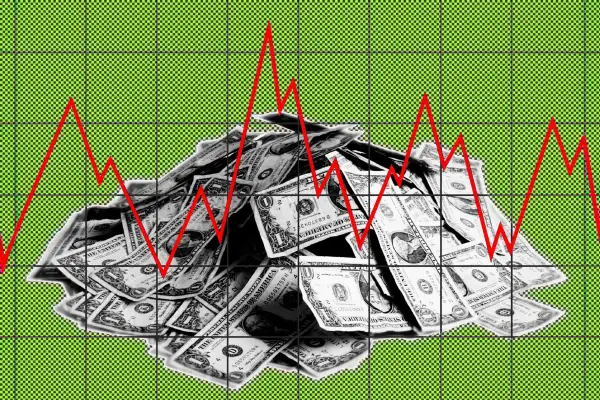Finance Giants Say 2024 Will Favor Active Investing Over Safer Passive Approaches
Money is not a client of any investment adviser featured on this page. The information provided on this page is for educational purposes only and is not intended as investment advice. Money does not offer advisory services.

There are, ultimately, two ways to invest. Most individuals are passive investors who, for good reason, shy away from risk and stick to their long-term plans regardless of what's happening in the stock market or the greater economy. Then there are others who choose to be active investors, taking on a lot more risk for the chance at beating the market.
Active styles of investing are not typically recommended for the average person. But in recent weeks, finance behemoths like UBS Wealth Management and BlackRock have said that the coming year and beyond will be better suited for active investors than passive ones.
"When I think about the opportunity for alpha [beating index funds], that’s where I get really excited — the most excited I’ve been in 20 years actually," Tony DeSpirito, BlackRock's chief investment officer of fundamental equities, said in a December meeting.
Institutions are excited by the prospect of beating the market, and they're confident enough to take on the risks of active investing to do it. But is this a feasible strategy for retail investors, and should you consider becoming more active with your investment portfolio in 2024?
Active investing vs. passive investing in 2024
Active investing is, on a basic level, just like it sounds. Active traders tend to check their portfolios frequently and are constantly assessing assets of their worth. They use their own benchmarks for evaluating stocks to hopefully identify investments that "beat the market," or outperform standard index funds that track the S&P 500 or other major market indices.
More specifically, active investing is an approach that “really tries to take discretionary decisions,” according to Joy Yang, head of product management and marketing at MarketVector Indexes. “They use their [investment portfolio] to deliver an investment goal. This could be to outperform some kind of benchmark or deliver income or preserve capital,” she adds.
Passive investing, on the other hand, follows a “rule-based approach,” rather than a discretionary one, Yang explains. “Even pure broad market benchmarks like the S&P 500 or MSCI World are rule-based approaches, because somebody had to define the rules at the beginning — investability criteria or what the weighting scheme is.”
More specifically, passive investors tend to adhere to much safer "set it and forget it" approaches to investing. Identifying fundamentally strong, long-term plays, passive investors will hold their investments through any sort of short-term shift in the market. By removing the timing element and impulse of active investing, this is a strategy that retail investors are wise to utilize in order to minimize the risk to their money.
Over the last few years, passive investing became increasingly popular among not just individual investors but financial institutions as a whole. The economic crisis facing the entire world at the onset of the pandemic led to the Federal Reserve greatly lowering interest rates and easing its monetary policy significantly. “It was really a rising tide lifting all boats,” DeSpirito said.
However, BlackRock and others expect that active investors will be rewarded most handsomely in 2024 and the near future as the Fed prepares to cut interest rates and tries to prepare the economy for its goal of a soft landing. Already, there are good signs in some corners of the economy, like historically low unemployment. More still is expected on the horizon, with mortgage rates expected to become more favorable and inflation approaching the Fed's target rate of 2%.
With macroeconomic factors shifting in this way, these institutions say that index funds may not deliver the gains they were in years prior, so they argue that it's now more worth the risk to actively invest. In its January note, BlackRock advised investors to keep some index funds in their portfolios, but shed some in favor of actively-managed investments.
Is active investing right for you?
With all of this in mind, active trading is not a strategy often employed by retail investors. Doing this tends to fly in the face of many rules of thumb, like holding investments long-term and not trying to time the market.
Active investing is also quite difficult to pull off successfully. Even fund managers who have spent years developing active investing strategies and bespoke valuation systems rarely tend to do any better than passive strategies.
“Historically, active managers just have not beaten the market in aggregate,” Yang says. “There may be really skilled active managers,” she adds. But, given that only 7% of active funds beat the market over the last decade, according to S&P's most recent Scorecard report, those successes are few and far between.
Of course, there are ways to actively invest without needing to do all of the hard work yourself. There are lots of actively managed investment funds out there, where investors give their money to fund managers to invest. However, the buy-ins for many actively managed funds are quite prohibitive to the average retail investor. There are steep requirements to participate in some of these funds, with $100,000 minimums, large fees and strict guidelines.
If you're not rich, or if you understandably don't feel confident enough to take on the significant risks of actively investing all by yourself, it may seem impossible to participate in what some might call the “year for active investing.” But Yang points to one investment that’s becoming increasingly popular: active exchange-traded funds. Active ETFs like BlackRock’s iShares represent a small but fast-growing portion of the ETF market. And, they don’t require the hefty buy-ins of other active funds, since ETFs have no minimums; you need only pay the cost of the shares you'd like.
“I think active managers have woken up to the fact that the ETF structure is so popular, and many of them want to wrap their strategies in an ETF,” Yang says.
Yet another disclaimer, though: Many active ETFs are simply mutual funds in a different "wrapper." Though the cost of participation is much lower through these products, remember that active managers still don’t regularly beat the market. In other words, there's no guaranteeing that active ETFs (or mutual funds) will perform any better than a basic index fund.
Ultimately, in most cases it's unwise to actively invest on your own. It's hugely research intensive and requires a level of expertise unpossessed by most. If you'd like to engage in active investing, Yang says going through a trustworthy financial advisor is your best bet. Or, at the very least, you should acknowledge that by actively trading based on your own decision process, you're taking on greater risk than by simply holding an index fund.
“For individuals, it's still best to use an investment advisor,” she says. “[Advisors] can actively allocate based on your investment goals, your risk profile, and their understanding of some of the macro drivers going on in the market. That's where I see more of the active management going: directly towards development allocation rather than bottom-up stock selection.”
More from Money:
This Investing Phenomenon Could Be Why Bitcoin Prices Are Down After ETF Approval
What's Next for Tech Stocks Now That Microsoft Has Overtaken Apple?
Investing Outlook: Expert Predictions for the Markets and More in 2024
